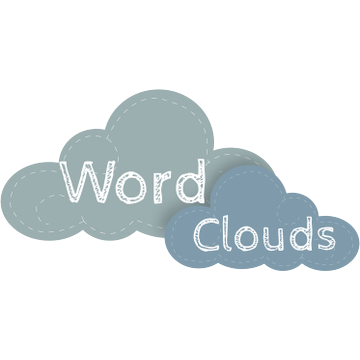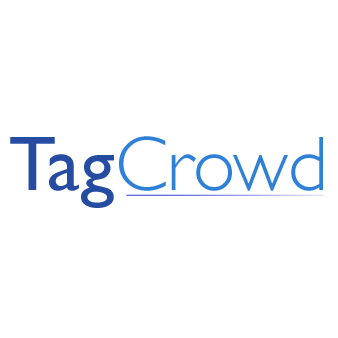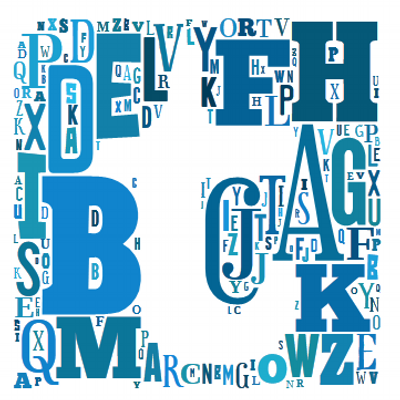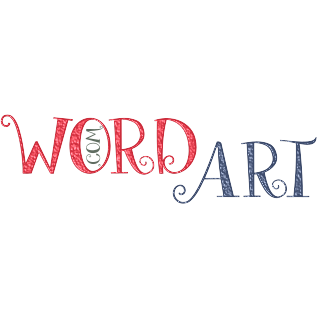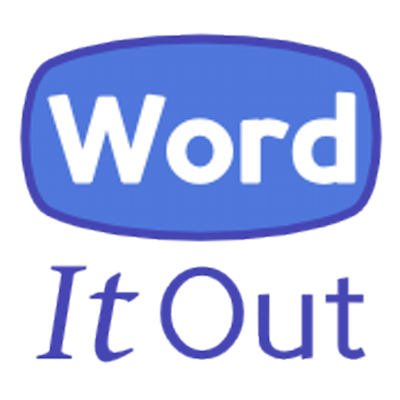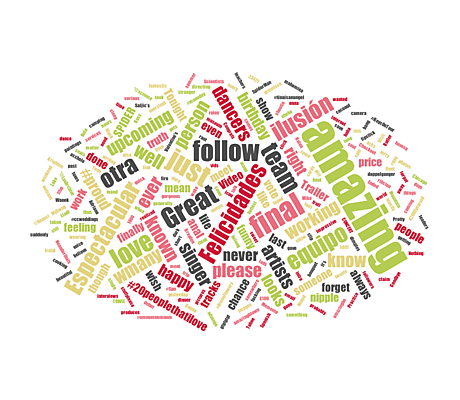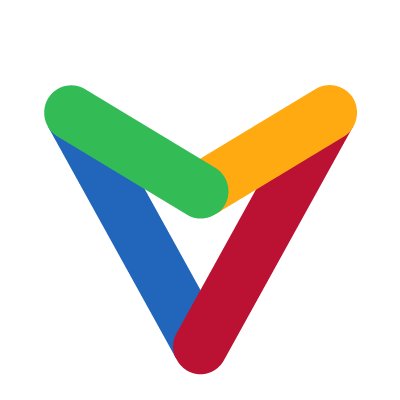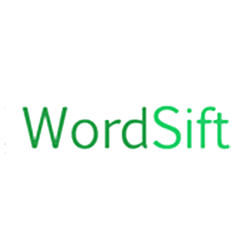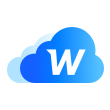Menu
Make a word cloud
Regenerate
Word cloud settings
Font
- sans-serif
- serif
- monospace
- Daniel
- Essays1743
- Gentium
- Gruenewald-VA
- Isabella
- Jura
- Sniglet
- Yiggivoo
Colour
Number of colours
5
For an unlimited number, set to 0.
Layout
Place largest word at the centre
Orientation
- Portrait
- Landscape
Aspect ratio
- Square (1:1)
- 4:3
- A4 (1.4142:1)
- 3:2
- 16:10
- 5:3
- 16:9
- 2:1
1.6 : 1
Custom aspect ratio
:
Width cannot be more than 10× height, & vice versa.
Word clouds always scale to fit.
Size
Difference in sizes of words
Words
Create a new Word list
Generating from a new source will not change your current word cloud settings.
However, changes made to individual words will be lost because a new word list will be created.
Total number of words
100
0 were found in the original source.
Minimum frequency
0
Only display words found at least this often.
The highest frequency is 0.
0 match the filtering criteria.
Display
Set by filtering criteria. Set manually by you.
Save
Original source
Normal text
Original text
Copy and paste the text of your document or try an example.
By default, the more frequently a word is found, the larger it becomes in the word cloud.
For example, enter a table, or apply no filter if words do not repeat.
No filter
Original text
Text is repeated in the word cloud as given. It is not counted, filtered or sorted.
Table
Table as text
Copy and paste from a spreadsheet or manually enter your own.
Separate columns with a tab, comma, colon or a space (see examples).
Minimum number of letters in a word
2
Filtered punctuation characters
Each will be removed from the beginning or end of any word. Replace with default.
Replace with a space
Each character is replaced by a non-breaking space, keeping words together.
About word clouds
A word cloud is an image made of words that together resemble a cloudy shape.
The size of a word shows how important it is e.g. how often it appears in a text — its frequency.
People typically use word clouds to easily produce a summary of large documents (reports, speeches), to create art on a topic (gifts, displays) or to visualise data (tables, surveys).
The Value of Our Free Word Cloud Generator
Speak’s AI word cloud generator uses machine learning and artificial intelligence to reveal insights, help with writer’s block, be a root as an AI content generator and more.
Word clouds are a great way to highlight the most important words, topics and phrases in a text passage based on frequency and relevance. Generate word clouds from your text data to create an easily understood visual breakdown for deeper analysis. Use our free word cloud generator below!
Speak’s online tool demo is the best free word cloud generator that can serve as your word cloud maker, allowing you to get a word cloud online and be a great tool for brainstorming word clouds so that you can present meaningful visualizations.
More than a free word cloud creator or a basic word cloud, Speak can generate clickable word clouds. Speak makes word cloud creation instant so you can make your own word cloud, word cloud art, tag cloud, Twitter word cloud generator or other variations of keyword cloud generators to drive value and understanding for stakeholders. You can even create a free wordle generator! The possibilities are endless with a word cloud creator free of risk and technical difficulties.
You can also check out how to transcribe a YouTube video to effortlessly bring valuable video content into Speak for transcription and analysis so that you can produce free word cloud generation.
What Is A Word Cloud?
Word clouds, also known as tag clouds, are visual representations of text data. They are used to provide insight into the structure, content, and meaning of a text by displaying the most frequently used words in the text.
What Data Is Good For Word Clouds?
Drop your text, call transcripts, customer reviews, blog content, website copy and more and instantly see brands, locations, numbers, events, products and more visualized. With a Speak account, you can add custom keywords and phrases that will also appear in your visualizations!
What Is The Purpose Of A Word Cloud?
This information can be useful for a variety of purposes, from market research to data analysis.
Words clouds are often used to explore relationships between words and phrases, allowing users to quickly gain an understanding of the text. For example, word clouds can be used to compare the language used in different files, identify the most frequently used words in a particular text, or uncover the meaning of a text by displaying the words in a visually appealing way.
The purpose of word clouds is to quickly convey information. By displaying the most frequently used words in a text, they can help to identify the main themes and topics of the text. This makes them a useful tool for market research, as they can help to identify the main topics that customers are interested in, as well as the language they use to talk about those topics.
Word clouds can also be used to compare multiple texts, audio files, video files and other types of unstructured language data media. Comparing the words used in each text can help to identify the similarities and differences between them. This can be useful for data analysis, as it can help to identify patterns and trends in the data.
Word clouds can also be used to help to get an understanding of the general sentiment of the text. For example, media full of negative words might imply a negative sentiment, while media with more positive words might imply a positive sentiment.
Word clouds can also be a useful tool for search engine optimization. Displaying the most important words and recurring words used in media can give you ideas and help you optimize your content for search engines.
Who Uses Word Clouds?
Word clouds are a popular tool for businesses of all sizes to visualize large amounts of data in a visually pleasing way. Word clouds are used by businesses to gain insights from customer feedback, surveys, and other sources of data. They are used to provide an overall picture of how customers feel about a product, service, or company.
Word clouds are used by small and medium-sized businesses, marketing agencies, market research firms, organizations with 51 to 1,000 employees, marketers, qualitative researchers, customer experience managers, market researchers, product researchers, SEO specialists, business analysts, data scientists, academic researchers, business owners and more.
Small & Medium Sized Businesses
Small and medium-sized businesses can use word clouds to gain insight into customer feedback and to get an overall picture of how customers feel about their product or service.
Word clouds can help small businesses gain a better understanding of the customer’s needs and wants, as well as what they are looking for in terms of product or service offerings. This understanding can be used to create better marketing campaigns and to help the business better understand its customer base.
Marketing Agencies
Marketing agencies can use word clouds to help them create more targeted campaigns. By understanding the customer’s needs and wants, marketing agencies can create campaigns that are more likely to resonate with the customer. Word clouds can also help marketing agencies identify the most popular words and phrases associated with a business or product, which can help them create more effective campaigns.
Market Research Firms
Market research firms can use word clouds to gain insights into customer feedback and to get a better understanding of customer sentiment. By understanding the customer’s needs and wants, market research firms can create better surveys and polls to gain more accurate feedback. Word clouds can also help market research firms identify the most common words and phrases associated with a business or product, which can help them create more effective surveys and polls.
Advantages And Disadvantages Of Word Clouds
It is also worthwhile to explore the advantages and disadvantages of using word clouds to visualize data. We’ll look at why they are useful for business owners and professionals, and how they can be detrimental if not used correctly. After reading this article, you should have a better understanding of what word clouds can do and how to best use them for your business needs.
Advantages of Word Clouds
Easily Interpretable
Word clouds make complex data more easily interpretable by transforming it into an eye-catching visual that can be understood by even those who aren’t familiar with interpreting data reports. This makes it easier for customers and business owners alike to identify trends within their data sets quickly and accurately.
Quickly Identify Keywords
By filtering out unnecessary words and displaying only the most common terms in a visually appealing manner, word clouds allow users to quickly identify keywords that are relevant to their search query or project objectives.
Creates Aesthetic Visuals
Word clouds are an aesthetically pleasing way to present data in a way that looks visually appealing without sacrificing accuracy or readability. This makes them great for presentations or online content that requires visual appeal for maximum impact on viewers.
Affordable & Easy To Set Up
Setting up a word cloud is relatively easy and affordable compared to other types of data visualization tools. Many online tools allow users to quickly set up word clouds with minimal effort required, making them ideal for those who don’t want to invest too much time or money into creating visuals from their data sets.
Disadvantages of Word Clouds
May Not Be Accurate Representation Of Data
While word clouds do provide an aesthetically pleasing representation of selected terms within a given data set, they cannot accurately represent the full scope of the information contained within it due to their simplified nature – meaning that any conclusions drawn from these visuals should be taken with a grain of salt until confirmed by further analysis.
Reduced Readability
Since the sizes of words displayed in a word cloud are determined by frequency rather than grammar rules, it can be difficult for readers to parse out individual words without enough context surrounding them which can lead to difficulties in understanding what is being presented – particularly when trying to spot patterns within dense data sets with multiple terms involved.
Not Customizable Enough For Complex Projects
Although word clouds are great for quickly presenting basic information in an attractive visual format, they may not be detailed enough when working on more complex projects as there aren’t many options available when it comes to customization or formatting features offered with most available services or software programs – like changing colours/backgrounds/fonts etc., which could limit its effectiveness depending on the type project being worked on or result desired from the visualization process.
What Is The Best Word Cloud Generator?
We’ve got a little bias here at Speak AI that our software is the best word cloud generator, but to help guide you on our journey we’ve also created a list of the best word cloud generator software so your data visualization journey is as successful as possible!
Use Our Free Speak Word Cloud Generator Tool!
Word clouds can offer businesses several advantages when used correctly including providing an easy-to-interpret visual representation of text-based data sets as well as identifying common keywords quickly and creating aesthetically pleasing visuals for presentations or online content purposes.
However, there are several drawbacks that need to be considered before using this tool such as reduced accuracy due to oversimplification and limited customization options which could limit its effectiveness depending on the project’s requirements or desired outcome from the visualization process.
As with any tool or technique used in business applications, understanding all potential advantages and disadvantages is key – so consider carefully before deciding if this tool is right for you and your business needs!
Word Clouds
Word Clouds are a visual representation of the frequency of words within a given body of text. Often they are used to visualize the frequency of words within large text documents, qualitative research data, public speeches, website tags, End User License Agreements (EULAs) and unstructured data sources.
Wordclouds.com
Wordclouds.com is a free online word cloud generator and tag cloud creator. Wordclouds.com works on your PC, Tablet or smartphone. Paste text, upload a document or open an URL to automatically generate a word- or tag cloud. Customize your cloud with shapes, themes, colors and fonts. You can also edit the word list, cloud size and gap size. Wordclouds.com can also generate clickable word clouds with links (image map). When you are satisfied with the result, save the image and share it online.
TagCrowd
TagCrowd is a web application for visualizing word frequencies in any text by creating word clouds, and was created by Daniel Steinbock while a PhD student at Stanford University. You can enter text in three ways: paste text, upload a text file or enter the URL of a web page to visualize.
Tagxedo
Tagxedo turns words into a visually stunning word cloud, words individually sized appropriately to highlight the frequencies of occurrence within the body of text. Start with any text and even use images to create a custom shape.
WordArt
WordArt.com is an online word cloud art creator that enables you to create amazing and unique word cloud art with ease. You can customize every bit of word cloud art including: words, shapes, fonts, colors, layouts and more!
ToCloud
ToCloud is an online free word cloud generator that uses word frequency as the weight. Based on the text from a webpage or pasted text, the generated word cloud of a page gives a quick understanding of how the page is optimized for certain words.
WordItOut
WordItOut is the word cloud generator that gives you control with many custom settings. Free to use and no sign up required!
Word Cloud Generator
Word Cloud Generator is developed by Jason Davies using JavaScript and provides a few customization options for scale, word orientation, font and the number of words from your original text to be included in the word cloud.
Vizzlo Word Cloud Generator
Vizzlo is an online data visualization tool, and creating word clouds is one of its capabilities. Vizzlo does have offer word cloud creation for free users, but it includes the Vizzlo watermark. You have to be on one of the paid accounts to remove the watermark.
Word Cloud Maker
Word Cloud Maker is an advanced online FREE word cloud generator that enables you to upload a background photo or select a design from the gallery upon which your word cloud art will be superimposed. You can simply download the word clouds to your local computer in multiple formats such as vector svg, png, jpg, jpeg, pdf and more. You can use it in your content for free.
Word Cloud Generator (Google Docs)
Word Cloud Generator is a free Google Docs add-on for creating word clouds based on your Google Documents. Richard Byrne has a good video tutorial that demonstrates how to quickly create a word cloud in Google Documents.
Infogram Word Clouds
Infogram is an online chart maker used to design infographics, presentations, reports and more. It’s free to create an account, and word clouds are one of their charting options. You have to upgrade to a paid plan to remove the Infogram logo and get access to download options for your designs.
WordSift
WordSift was created to help teachers manage the demands of vocabulary and academic language in their text materials. Options are very similar to Jason Davies’ Word Cloud Maker (above) but is easier to use.
MonkeyLearn AI WordCloud Generator
The MonkeyLearn WordCloud Generator is a free tool that uses Artificial Intelligence to generate word clouds from your source text, and automatically detects multiple word combinations.
Wordle (discontinued)
Wordle was a Java-based tool for generating “word clouds” from text that you provide, created by Jonathan Feinberg. Wordle has been discontinued and is no longer under development. You can download and use the final version of the desktop apps for Windows v0.2 and Mac v0.2. These desktop apps require that JAVA is also installed on your computer.

